Kazan drone attack: The incident, shrouded in uncertainty, immediately sparked international attention. Reports of damage and potential casualties fueled speculation about the perpetrators and their motives, raising concerns about regional stability and the escalating use of drone technology in conflict zones. Understanding the event requires examining the technological capabilities of the drones involved, the geopolitical context, and the official responses to the attack.
This analysis delves into the specifics of the Kazan drone attack, exploring the timeline of events, the potential actors, and the broader implications for regional security. We’ll examine the technological aspects of the drones used, the countermeasures available, and the ongoing investigations. Furthermore, we’ll analyze media coverage and public perception to paint a complete picture of this significant event.
The Kazan Drone Attack: An Analysis
Reports of a drone attack in Kazan, Russia, have raised significant concerns regarding regional security and the evolving capabilities of unmanned aerial vehicles (UAVs) in modern conflict. This analysis delves into the event, exploring the potential actors, technological aspects, geopolitical implications, and the public’s perception of the incident.
The Kazan Drone Attack Overview
Reports emerged detailing an alleged drone attack on Kazan, a significant city in Tatarstan, Russia. While details remain fragmented and official confirmation is pending, initial reports suggested multiple drones were involved, targeting unspecified infrastructure. The extent of damage and casualties remains unclear, with conflicting information circulating in various news outlets. The incident sparked immediate speculation regarding the perpetrators and their motives, adding another layer of complexity to an already tense geopolitical landscape.
Initial reports were followed by a period of information uncertainty, with official statements being relatively scarce. Subsequent updates provided varying accounts of the damage and the number of casualties, highlighting the challenges in verifying information amidst a rapidly evolving situation. This lack of immediate transparency fueled speculation and contributed to the spread of misinformation across various media platforms.
| Date | Time | Location | Reported Casualties | Reported Damage |
|---|---|---|---|---|
| [Insert Date] | [Insert Time] | Kazan, Tatarstan, Russia | [Insert Number, or “Unconfirmed”] | [Insert Description, or “Unconfirmed”] |
Identifying Potential Actors and Motives

Several actors could potentially be linked to the alleged drone attack, ranging from domestic dissident groups to external state actors. Attribution remains challenging due to the lack of conclusive evidence. Potential motives are equally diverse, ranging from expressions of political dissent to strategic actions designed to destabilize the region. Geopolitical tensions in the region, particularly concerning the ongoing conflict in Ukraine, add another layer of complexity to the analysis of potential motivations.
The recent Kazan drone attack highlights the evolving threat of unmanned aerial vehicles. This underscores the need for robust counter-drone technologies, a stark contrast to the dazzling spectacle of a well-orchestrated drone show, such as the one showcased at the orlando drone show. The peaceful, artistic applications of drones shown there emphasize the crucial need to differentiate between legitimate uses and malicious intent, as seen in the Kazan incident.
The methods employed in the alleged attack are likely to involve commercially available drones modified for offensive capabilities. This could include enhancements to payload capacity, range, and navigation systems, potentially utilizing GPS spoofing or other techniques to evade detection.
Drone Capabilities and Countermeasures

The drones potentially used in the attack could range from commercially available models modified for offensive purposes to more sophisticated military-grade UAVs. Key technological capabilities include extended flight range, enhanced payload capacity allowing for the delivery of explosives or other harmful materials, and sophisticated navigation systems enabling precision targeting. The effectiveness of these drones is directly tied to their ability to evade detection and countermeasures.
Existing counter-drone technologies encompass various approaches, including radar systems for detection, electronic warfare to disrupt drone control signals, and physical interception using nets or directed energy weapons. The effectiveness of these technologies depends on factors such as the sophistication of the drone being countered, the terrain, and the technological capabilities of the countermeasures deployed.
A hypothetical countermeasure strategy would involve a multi-layered approach combining early warning systems, electronic countermeasures, physical interception capabilities, and robust cybersecurity measures to protect critical infrastructure from drone attacks. This would require investment in advanced technologies and coordinated efforts across various agencies and levels of government.
The recent drone attack on Kazan highlights the evolving nature of modern warfare. It’s a stark contrast to the whimsical tracking of Santa Claus, where you can call the norad santa tracker phone number for a festive update. However, both incidents underscore the importance of sophisticated surveillance and defense systems in protecting civilian populations and infrastructure against potential threats, whether from malicious actors or, well, jolly old Saint Nick.
Geopolitical Context and Implications

The alleged drone attack occurred within a complex geopolitical context marked by ongoing regional tensions and international conflicts. The incident’s potential implications for regional stability are significant, raising concerns about escalating conflicts and the potential for further destabilization. Comparisons can be drawn to similar events in the region, highlighting the growing use of drones in asymmetric warfare and the challenges in maintaining security in a volatile environment.
Potential long-term consequences for international relations include heightened security concerns, increased investment in counter-drone technologies, and potential shifts in regional alliances and power dynamics. The incident could also further strain relationships between Russia and other countries, potentially exacerbating existing geopolitical tensions.
Information Dissemination and Public Perception
Initial media reports on the Kazan drone attack varied considerably, with some focusing on the potential damage and casualties, while others emphasized the lack of official confirmation and the ongoing investigation. The narrative evolved as more information became available, with some outlets highlighting the potential implications for regional security while others emphasized the need for caution in interpreting unverified information.
Public reaction ranged from concern and apprehension to skepticism and outright dismissal, depending on the source of information and the individual’s political leanings.
- Outlet A: Focused on casualty numbers, emphasizing the severity of the attack.
- Outlet B: Highlighted the lack of official confirmation, expressing skepticism about the reports.
- Outlet C: Analyzed the geopolitical implications, connecting the event to broader regional tensions.
Official Responses and Investigations, Kazan drone attack
Official responses from Russian authorities have been relatively restrained, with initial statements acknowledging the incident but refraining from confirming details or assigning blame. Investigations are likely underway to determine the facts of the event, identify those responsible, and assess the extent of the damage. Measures to prevent future occurrences will likely involve increased security measures, improved drone detection capabilities, and potentially stricter regulations surrounding the sale and use of UAVs.
Security measures implemented in the aftermath likely include enhanced surveillance, stricter access controls to critical infrastructure, and potentially the deployment of additional counter-drone technologies. The long-term impact on security protocols and resource allocation will depend on the findings of the ongoing investigation and the assessed level of future threat.
The Kazan drone attack serves as a stark reminder of the evolving nature of modern conflict and the potential for escalating tensions. The incident highlights the need for improved drone detection and countermeasure technologies, as well as a deeper understanding of the geopolitical factors driving such attacks. Further investigations and international cooperation are crucial to prevent similar incidents and mitigate the potential for wider regional instability.
The recent drone attack on Kazan highlights the growing concern over the misuse of unmanned aerial vehicles. This incident, while geographically distant, shares a concerning parallel with technological malfunctions; for instance, the unexpected issues experienced during a recent drone show, as detailed in this report on the orlando drone show malfunction , underscore the need for robust safety protocols and reliable technology across all drone applications, especially given the potential for similar incidents to occur in other contexts, like the Kazan attack.
The long-term consequences remain to be seen, but the event undoubtedly marks a significant development in the region’s security landscape.
Top FAQs
What type of damage was reported in the Kazan drone attack?
Reports varied, but initial accounts suggested damage to infrastructure and possibly some injuries. Precise details are still emerging as investigations continue.
Were any arrests made in connection with the attack?
Official statements regarding arrests haven’t been publicly released. Investigations are ongoing to determine responsibility.
What is the current status of the investigation?
Authorities are actively investigating the incident, but the details of their findings remain confidential at this time.
